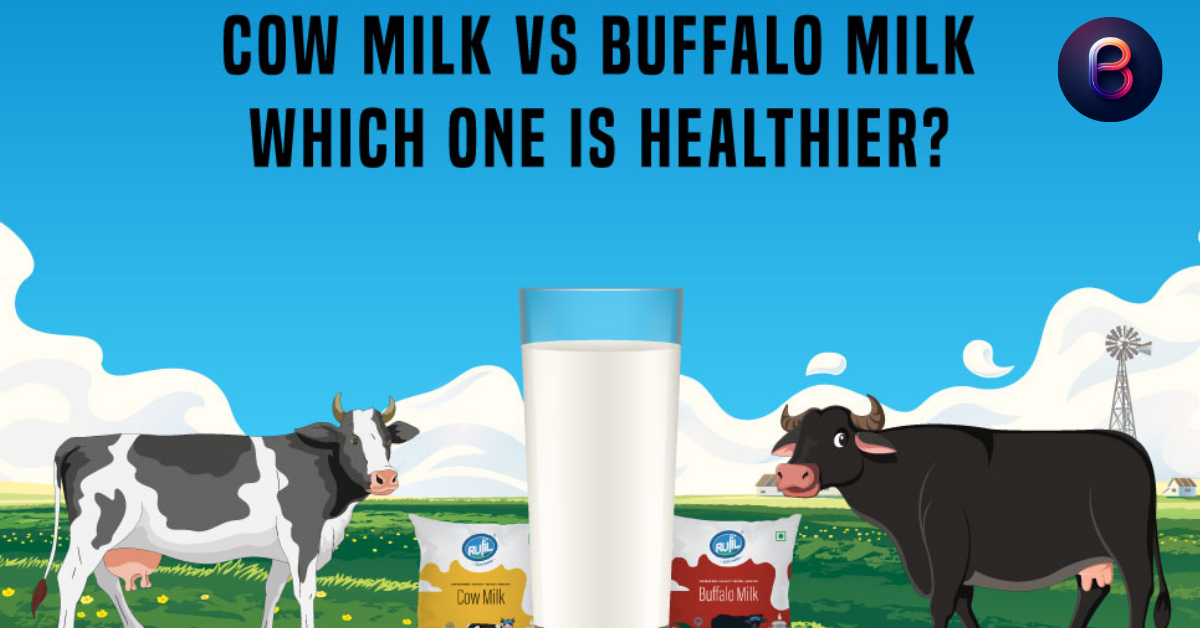Have you ever wondered about the difference between buffalo milk and cow milk? Both are popular choices for people around the world, but they have unique qualities that make them special. This article will help you understand their nutritional differences, benefits, and how they fit into your diet. Whether you’re choosing milk for your morning cereal or a tasty smoothie, knowing which type suits you best can make a big difference! Let’s dive into the tasty world of these two types of milk and discover which one might be the right choice for you.
Nutritional Composition
Protein Content
When we look at buffalo milk and cow milk, one of the biggest differences is how much protein they have. Buffalo milk has about 4.5% to 5% protein, while cow milk has around 3% to 3.5% protein. This means that buffalo milk has more protein, which can help you feel full longer and is great for building muscles. For kids who are growing, protein is super important because it helps their bodies develop strong muscles and bones.

Also Check: Why Corteiz Clothing Is the New Must-Have Brand
Fat Content
Next up is fat! Buffalo milk contains more fat than cow milk. Buffalo milk usually has 6% to 7% fat, while cow milk has about 3% to 4% fat. Fat is important because it gives you energy and helps your body absorb vitamins. Some people prefer the creaminess of buffalo milk in their food and drinks, making it a popular choice for making rich desserts and cheeses. However, if you’re watching your fat intake, cow milk might be the better option.
Vitamins and Minerals
Now, let’s talk about vitamins and minerals! Both types of milk are packed with goodies like calcium and vitamins A and D, which are great for strong bones and healthy skin. However, buffalo milk has more vitamins and minerals overall. It’s especially high in calcium, which helps build strong bones, and also has more antioxidants that can help keep you healthy. So, if you want a boost of nutrients, buffalo milk might be the way to go!
Digestibility and Lactose Sensitivity
Lactose Levels
Have you ever heard of lactose? It’s a sugar found in milk. People who are lactose intolerant can have a hard time digesting it, which can lead to stomach aches. Buffalo milk has a bit more lactose than cow milk, but some people find that they can digest buffalo milk better. This might be because of the different types of proteins in each milk. If you’re lactose intolerant, you might want to try both types to see which one your tummy likes better.
Digestive Health
How well your body digests milk can make a big difference! The proteins in buffalo milk are different from those in cow milk, which might make them easier or harder to digest for some people. Plus, buffalo milk has smaller fat globules, which can help with digestion. If you often have stomach problems, it’s good to pay attention to how each type of milk makes you feel.
Health Benefits
Overall Health Advantages
Both buffalo milk and cow milk have health benefits, but they help in different ways. Buffalo milk is rich in antioxidants, which help fight off diseases and keep your body healthy. It may also be better for your heart because it has more healthy fats. On the other hand, cow milk is lower in calories and cholesterol, making it a good choice if you’re watching your weight.
Cultural and Traditional Perspectives
Different cultures enjoy milk in unique ways. In some places, buffalo milk is a staple, especially in countries like India, where it’s used to make delicious sweets and yogurt. Cow milk is widely used in many parts of the world, and its products, like cheese and butter, are loved everywhere. Understanding how different cultures use these types of milk can help you appreciate their flavors and health benefits even more.
Allergic Reactions and Intolerances
It’s also important to consider allergies! Many kids are allergic to cow milk, while allergies to buffalo milk are less common. If you have a milk allergy, it’s best to avoid both types and talk to your doctor about alternatives.
Environmental Impact
Sustainability of Production
When it comes to the environment, the way we produce milk matters. Buffalo milk generally requires more water and food for the animals than cow milk, which can have a bigger environmental footprint However, buffalo farming can be more sustainable in certain regions, so it’s essential to consider where the milk is coming from.
Economic Considerations
From an economic viewpoint, buffalo milk can be more expensive than cow milk due to the higher costs of production. This means that in some areas, cow milk might be the more affordable choice for families.
Culinary Applications
Culinary Uses and Recipes
Both types of milk can be used in delicious recipes! Buffalo milk is creamy and thick, making it great for making paneer, yogurt, and rich desserts like kheer. Cow milk, on the other hand, is commonly used for making cheese, ice cream, and other dairy product. You can try using each type of milk in your favorite recipes to see which flavor you prefer!
Milk-Based Products
There are lots of milk-based products you can enjoy! Buffalo milk is used to make unique cheeses like mozzarella, while cow milk is famous for varieties like cheddar and cream cheese. When choosing products, check the labels to see which type of milk is used and decide which one you’d like to try.

Also Check: Stay On Track: Truemeds App for Medication Reminders
FAQs
Which milk is better for weight loss: buffalo milk or cow milk?
If you’re trying to lose weight, cow milk might be the better choice. It usually has less fat and fewer calories than buffalo milk. Cow milk has about 3-4% fat, while buffalo milk has around 6-7% fat, which means it can add more calories to your diet. However, buffalo milk has more protein, which can help you feel full for longer. So, it really depends on what you prefer in your diet!
Can buffalo milk help with lactose intolerance?
Both buffalo milk and cow milk have lactose, but some people who are lactose intolerant find buffalo milk easier to digest. This could be because the fat particles in buffalo milk are smaller, which might help with digestion. If you are lactose intolerant, it’s a good idea to try a small amount of buffalo milk and see how your body reacts.
How do the taste and texture differ between the two milks?
Buffalo milk is known for being rich and creamy, which makes it great for making cheese and desserts. It has a slightly sweet taste that many people enjoy. On the other hand, cow milk is lighter and has a milder flavor, making it a versatile choice for everyday uses, like in cereal or coffee. Depending on what you’re cooking, you might choose one type of milk over the other.
Conclusion
In conclusion, choosing between buffalo milk and cow milk depends on your dietary needs and preferences. Buffalo milk offers higher protein and creaminess, while cow milk is lighter with fewer calories. Both have unique benefits, so consider what works best for you





